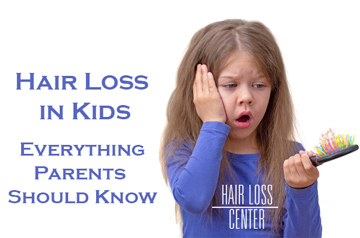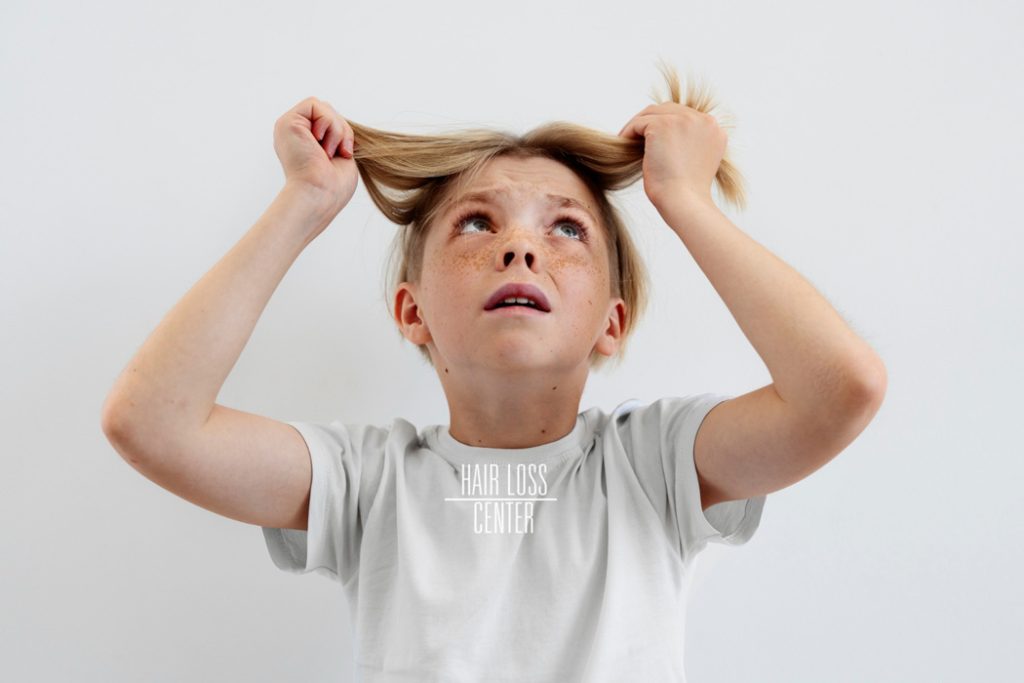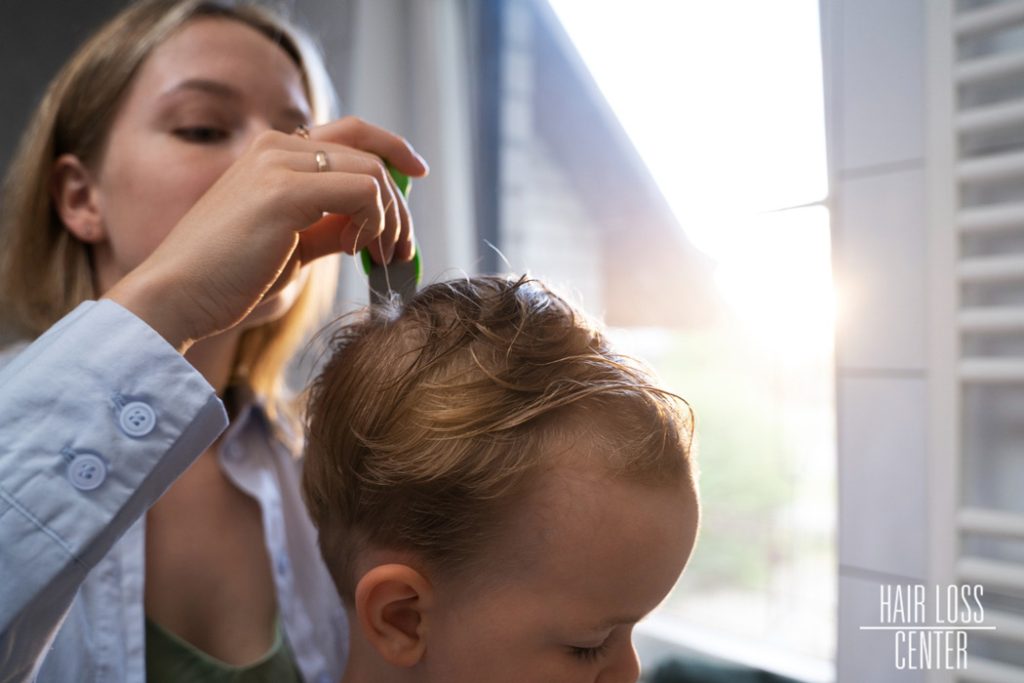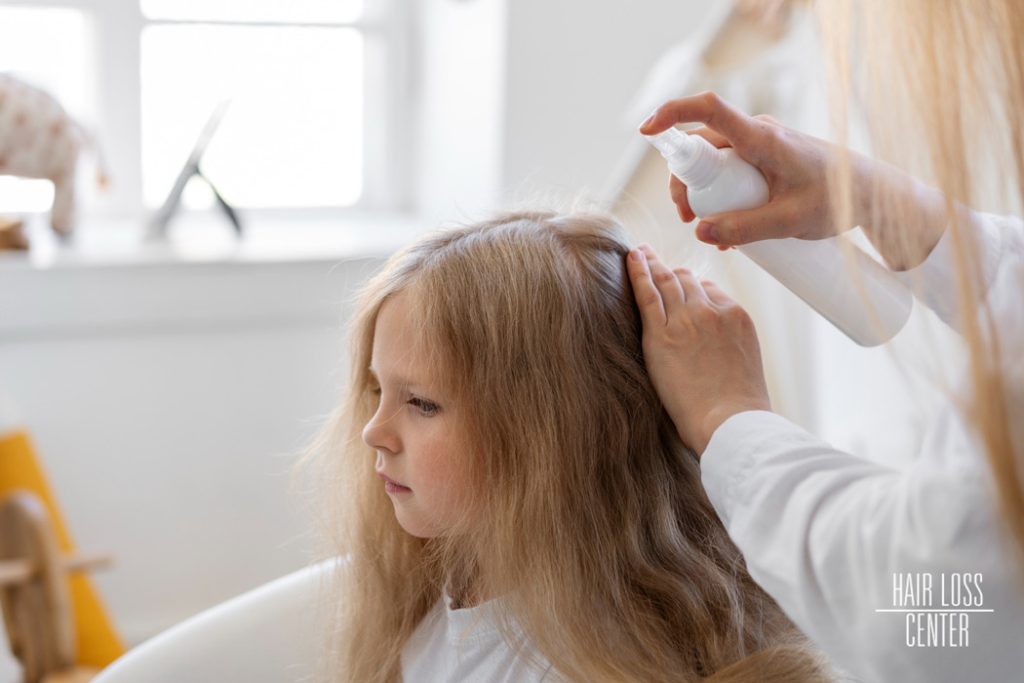

Hair Loss in Kids: Everything Parents Should Know
There’s no doubt that seeing your child lose hair can be a shocking and distressing experience, however, you’re the one who should take the lead and deal with it. Hair loss in kids is not uncommon and that’s our hair loss experts have decided to put together a complete guide for parents dealing with their children’s hair loss.
In this comprehensive guide, we’ll discuss the common causes of hair loss in children, what solutions and treatments can be effective, and what parents can do to help their kids go through this more easily.
At the end, we’ll discuss some FAQs about pediatric hair loss.
Lift your kid’s spirit during hair loss with quality human hair wigs for kids. This can easily restore their confidence.
Call our Hair Loss Centers in Southern California for more information.
What Can Cause Hair Loss in a Child?
The first thing any parents should know is what can cause hair loss in kids, so they can act more quickly and sensibly.
Except for excessive hair shedding as a result of some medical treatments, like chemotherapy, there are a few other reasons for hair loss in toddlers or older children. Let’s discuss them separately.
1. Scalp Ringworm in Kids (Tinea Capitis)
One of the most common hair conditions in children is a fungal infection called scalp ringworm. It results in bald patches on the scalp and can spread from one person to the next by combs, hats, etc. So, it’s important to start treatment immediately.
Common Symptoms of Scalp Ringworm
- Black dots on the bald patches
- The scalp can get red, scaly, bumpy, and itchy.
- Brittle hair
- The lymph nodes on the neck can become swollen.
Tinea Capitis Treatment
The treatment usually includes oral antifungal medication as well as antifungal shampoo. Also, it can take several weeks to a couple of months to be treated completely depending on the severity of the condition. So, parents should act promptly to shorten the treatment process and severity of the symptoms.
The good news is that the hair starts growing back after a while, although the strands can be fragile and thin in the beginning.
2. Alopecia Areata in Children
Alopecia in children is not uncommon. They start to lose hair in the form of round patches which are not limited to the scalp and can cover the whole body.
What Causes Alopecia in Children?
Alopecia areata is an autoimmune condition in which the immune system starts attacking hair follicles, resulting in bald spots.
This usually has a genetic reason. That’s why in families that have a history of alopecia areata or other autoimmune diseases, kids are more likely to suffer from this condition. Plus, in these individuals, some factors such as pollutants, stress, and viral infections may trigger alopecia areata or worsen it.
Alopecia Areata Symptoms and Treatment
- Hair loss
- One or more bald patches without any inflation or redness
- This white hair may grow in bald spots
- Nail pitting or discoloration
- Mild itchy scalp before hair loss
Please note that each patient can experience only a couple of these symptoms not all of them.
However, alopecia areata treatment is more complicated compared to scalp ringworm. Usually, a combination of treatments is prescribed that can include topical and oral medications as well as injections of corticosteroids. These can help reduce the symptoms and enhance hair regrowth.
Unfortunately, in many cases, alopecia in kids is a chronic problem and needs ongoing treatment to manage the condition. So, we can’t say how long the treatment can take or how effective it can be.
A common solution is using alopecia wigs for kids to hide the spots and prevent further irritation.
3. Trichotillomania in Kids

Trichotillomania is a kind of obsessive-compulsive behavior in which kids start to pull out their own hair. This hair-pulling urge often leads to bald spots and damaged hair.
Trichotillomania hair loss is mostly caused by some kind of emotional or psychological stress. That’s why the treatment usually includes behavioral therapies, like
- cognitive-behavioral therapy (CBT),
- habit reversal training (HRT),
- and acceptance and commitment therapy (ACT).
But in some cases, medications can be prescribed to help manage the urge better. Besides, the patient can benefit from some medications to improve hair regrowth.
Depending on the severity of the condition and the child’s response, the behavioral therapies can last between a few weeks to several months.
Therefore, to stop the condition from getting more severe, parents should immediately seek help from mental health professionals to intervene and start the treatments. Normally, the hair starts to regrow after a while.
4. Temporary Hair Loss in Kids
Telogen effluvium (temporary excessive hair shedding) typically appears as diffused hair loss rather than bald spots and can be caused by
- stress,
- illness,
- medications,
- hormonal changes,
- and nutritional deficiency.
These triggers disrupt the natural cycle of hair growth and cause the follicles to enter the resting phase, called telogen, prematurely.
To treat temporary hair shedding in kids first, the underlying cause must be diagnosed. After dealing with this underlying condition, the hair starts to regrow. Some medications can be prescribed to enhance the hair regrowth process.
5. Traumatic Hair Fall in Children
Burns, injuries, and even tight hairstyles can cause physical trauma to hair follicles. Any tension on follicles can lead to hair loss in the affected area.
There are a few treatment options available, however, the best decision depends on the cause of the trauma and the severity of hair loss.
- Topical treatments, such as Minoxidil, can enhance hair regrowth.
- Platelet-rich plasma therapy (PRP), which involves injecting the patient’s platelet into the scalp, stimulates follicles.
- Low-level laser therapy (LLLT) stimulates hair follicles and promotes regrowth.
- Hair transplant is another option for more severe cases where the possibility of hair regrowth is low. For example, when hair follicles are damaged in burned areas.
Keep in mind that the effectiveness and the duration of these treatments vary for each case. Your child’s dermatologist will recommend the best treatment based on the patient’s specific conditions.
Genetic Hair Loss in Kids

Some genetic or congenital conditions can lead to hair disorders in kids. For instance,
- Loose Anagen Syndrome (LAS):
LAS is found in kids and is characterized by hair strands that can very easily fall. So, their hair can’t grow long and shed prematurely. As it’s a genetic condition that affects the hair growth cycle, treating and managing it is challenging.
So, parents should ensure following the health care professional’s advice on haircare practices and prescriptions to promote hair growth and manage the symptoms.
- Monilethrix:
Monilethrix is another genetic hair disorder in kids that causes them to have brittle and fragile hair. The hair shaft looks usually like a string of beads that sheds easily and is very dry. So, the treatment includes specific haircare practices, topical medications, and nutritional support.
Unfortunately, this disorder will never be treated completely but seeking help from a dermatologist and following the recommended haircare plan can significantly improve the condition and hair quality.
Overall, seeing a sudden bald spot on a child’s head comes as a shock but in many cases, hair loss in kids can be treated or at least managed if parents take action quickly and seek professional help. However, this is not all. Parents should also learn how to manage their own and their kid’s emotions while going through this process. In the next section, we’ll discuss it more.
Check out our special hair care products here.
How Parents Should Cope with Sudden Hair Loss in Kids?
Aside from seeking professional help, parents with kids going through hair loss should pay attention to the tips below.
Emotional Support
When we’re sick, it’s not just the symptoms that bother us. In many cases, especially when there are changes to our appearance and physical abilities, we also experience psychological pain. These psychological side effects can be ten times worse in kids. That’s why parents should learn how to provide emotional support for their young ones.
Here are a few suggestions to improve your children’s emotional well-being when they’re experiencing hair loss and going through treatments.
- Boost their self-esteem by assuring them that they’re loved by you and other family members no matter how they look.
- Make sure they know you’re there for them and you’re ready to provide any kind of emotional/professional support they need to get better more quickly.
- Try to explain the condition and treatments in a way that they understand. Be honest but don’t give them too much information that makes them anxious. This open communication allows them to talk about their feelings as well.
- Don’t judge their feelings or deny them. Whatever they’re feeling is real for them.
- Talk about their options. Let them play an active role if they’re old enough in selecting a hair loss solution and treatment. For example, if they prefer to hide it by wearing a hat or a wig, or they feel comfortable without them.
- Educate other family members, your kid’s friends, and relatives to understand the situation and respect your child.
- Educate yourself about the specific condition your child has and manage your behavior and emotions, particularly in their presence.
- Seek professional mental health support if needed.
Precautions: Tips to Prevent Hair Loss in Young Children

As we have discussed above, most cases of hair loss in children can be prevented or managed significantly by following some preventive measures.
- Teach your kids since they’re very young not to share their personal items with others. Good personal hygiene is necessary to avoid infections.
- Stress is a big cause of hair loss regardless of age. Manage and deal with your child’s stress.
- Make sure your kids are getting all the nutrients necessary for them. Nutritional deficiency can cause hair shedding or make the condition worse.
- Prevent your kids from using tight hairstyles or any other activities that can put too much tension on their hair.
- If there’s any medical condition you should consult with a healthcare professional ASAP. Addressing health issues at an early stage is necessary to avoid severe symptoms and side effects.
Hair Replacement Solutions
It takes a while for hair loss treatments to work and our hair goes back to its normal state. For kids, this process can be tiring and cause emotional/psychological problems. For example, they may feel embarrassed at school.
So, you can introduce them to the options they have to hide their bald spots and provide more privacy. It also makes them feel better about themselves and restore their confidence. Here are some solutions.
- High-quality wigs for kids: You can order a custom wig or even hair pieces that blend with the child’s natural hair to cover the bald spot. It may even be possible to make wigs from their own hair.
- Wearing hats and scarves.
- Using some hair accessories, like headbands, bows, bandanas, etc.
- Temporary hair color sprays that add color to the bald spots and help to hide them better.
All in all, as parents, your first priority should be what makes your child feel better during this process.
FAQs about Children Hair Loss
Here are some questions we get often from concerned parents.
How to Explain Alopecia to a Child?
Whether it’s them or someone else in the family suffering from alopecia, it’s important to explain the condition to the child simply in a way that they can understand. In this way, they can accept it more easily. To do so, you should
- use simple words and language and get help from visual aids suitable for kids you can find online.
- Be honest with them. For example, if the condition is chronic, don’t lie to them about total improvement.
- Encourage them to ask their questions and discuss their feelings.
Is It Normal for Children’s Hair to Fall Out?
Losing 50 to 100 hairs per day is normal. If there’s a sudden increase in your child’s hair fall, consult with a dermatologist or his/her pediatrician.
I Found a Small Bald Spot on My Daughter’s Head, What Should I Do?
Visit a dermatologist immediately to identify the underlying cause and start proper treatment. In most cases, children’s hair loss is treatable but it needs to be addressed quickly.
Where Can I Consult with a Wig Expert for My Kid in Southern California?
At our Hair Loss Centers in Los Angeles (310-991-0087), San Diego (949-640-4247), and Newport Beach (949-322-9555) we offer a free consultation session with our hair loss experts. You can take your child after scheduling an appointment and have a private conversation with one of our experienced staff. Give us a call, we’re here for you.
LA OFFICE
Beverly Hills
8383 Wilshire Blvd, Suite 800
Los Angeles, CA 90211
ORANGE COUNTY OFFICE
NEWPORT BEACH
240 Newport Center Drive, Suite 111
Newport Beach, CA 92660
SAN DIEGO OFFICE
LA JOLLA
4660 La Jolla Village Dr. Suite100
San Diego, CA 92122
NEWPORT HAIR LOSS CENTER
Newport Hair Loss Center gives hair loss sufferers a way to restore their appearance and boost their confidence, whether they are suffering from trichotillomania, alopecia, or are currently going through chemotherapy.
Site Map

